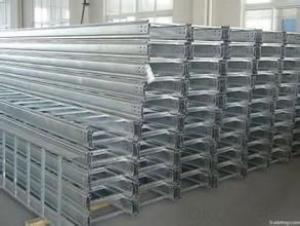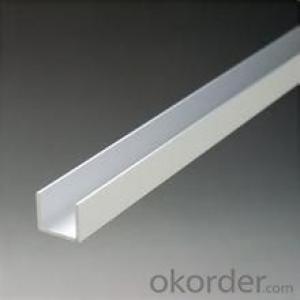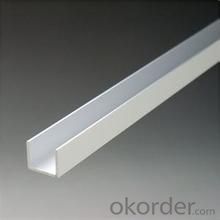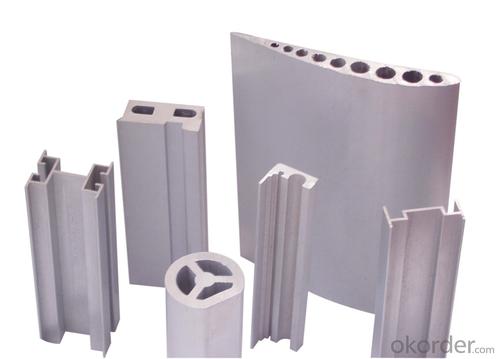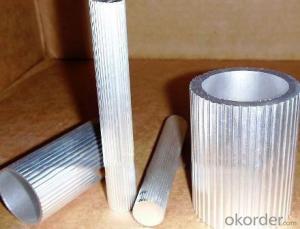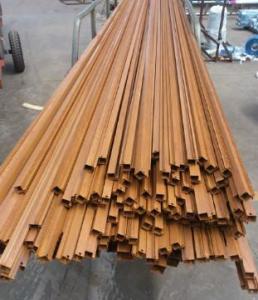Aluminum Extrusion Profiles Philippines - Various Surface Treatment Grade Top Industrial Aluminium Profile Extrusion
OKorder Service Pledge
OKorder Financial Service
You Might Also Like
Aluminium is a relatively soft, durable, lightweight, ductileand malleablemetalwith appearance ranging from silvery to dull gray, depending on the surfaceroughness. It is nonmagnetic and does not easily ignite. A fresh film ofaluminium serves as a good reflector (approximately 92%) of visible lightand an excellent reflector (as much as 98%) of medium and far infraredradiation. The yield strength of pure aluminium is 7–11 MPa,while aluminium alloys have yield strengths ranging from200 MPa to 600 MPa. Aluminium has about one-third the densityand stiffness of steel. It is easily machined,cast, drawn and extruded.
Features:
Material | Alloy 6063,6061,6005or according to customer’s choice |
Temper | T3, T4, T5, T6 |
Surface | Anodize, electrophoresis, powder coating, PVDF coating, wood grain painting, matted, etc. |
Length | Coating 6.5 meters, Anodizing 6.5 meters, Mill finish 5 meters |
Application | Industrial, electrical equipment(TV set, air conditioner, refrigerator, computer), decoration,construction, transportation |
Custom Made | We can package following with customer's request. |






- Q: What are the water resistance properties of aluminum profiles?
- The water resistance properties of aluminum profiles are exceptional. Aluminum itself has inherent resistance to corrosion, and when properly coated or anodized, it becomes even more resistant to water damage. Through the coating or anodization process, a protective layer forms on the aluminum surface, acting as a barrier against water penetration. Aluminum profiles find widespread use in various applications that involve exposure to water, such as windows, doors, and outdoor structures. Thanks to their water resistance properties, they can withstand moisture, rain, and humidity without deteriorating or rusting. Moreover, aluminum profiles have the advantage of being lightweight, making them ideal for water-related environments like marine applications. Despite their lightweight nature, they offer high strength and durability, enabling them to endure the harsh conditions associated with water contact. To summarize, aluminum profiles possess excellent water resistance due to their natural corrosion resistance and the protective coatings or anodization they undergo. This makes them a reliable choice for applications expecting water exposure, ensuring long-lasting performance with minimal maintenance needs.
- Q: How do you prevent warping or distortion of aluminum profiles during fabrication?
- To prevent warping or distortion of aluminum profiles during fabrication, there are several key steps that can be taken: 1. Proper storage: Before fabrication, it is crucial to store aluminum profiles in a controlled environment with stable temperature and humidity levels. This helps to minimize any potential changes in the metal's shape or dimensions. 2. Correct handling: Aluminum profiles should be handled with care to avoid bending or twisting. This includes using appropriate lifting equipment, avoiding excessive force, and ensuring that the profiles are supported evenly during transportation. 3. Proper machining techniques: During fabrication, it is important to use appropriate machining techniques that minimize heat buildup. Excessive heat can cause the aluminum to expand and potentially warp. Cooling techniques like using lubricants or coolants can help dissipate heat and prevent distortion. 4. Controlled welding: When welding aluminum profiles, it is crucial to maintain proper control over the welding process. The use of appropriate welding techniques, such as preheating and post-weld heat treatment, can help minimize distortion. 5. Adequate fixturing: Using proper fixturing methods during fabrication helps ensure that the aluminum profiles are held in the correct position throughout the process. This prevents any unintended bending or warping that could occur due to improper support or clamping. 6. Stress-relieving: After fabrication, stress-relieving processes can be employed to minimize residual stresses within the aluminum profiles. This helps to prevent distortion or warping that may occur during subsequent handling or usage. 7. Quality control: Regular inspection and measurement of the aluminum profiles during fabrication can help identify any deviations from the desired specifications. This enables quick corrective actions to be taken, minimizing the risk of warping or distortion. By following these steps, manufacturers can significantly reduce the likelihood of warping or distortion in aluminum profiles during fabrication, ensuring the production of high-quality components or products.
- Q: Can aluminum profiles be used for greenhouse construction?
- Indeed, greenhouse construction can make use of aluminum profiles. The durability, lightweight characteristics, and corrosion resistance of aluminum make it a favored selection for greenhouse frames. Moreover, aluminum proves to be easily manageable, enabling flexibility in design and construction. The utilization of aluminum profiles yields a robust and steady structure capable of enduring severe weather conditions and providing enduring support for greenhouse coverings. Furthermore, aluminum frames necessitate minimal upkeep and possess a lengthier lifespan in comparison to alternative materials, rendering them a cost-efficient choice for greenhouse construction.
- Q: This question asks for a method to determine whether the building materials include aluminum profiles.
- <p>To determine if your current building uses aluminum profiles, you can start by examining the visible structural components such as window frames, door frames, and support beams. Look for the characteristic silvery color and smooth finish of aluminum. You can also check the building's documentation or blueprints, if available, for material specifications. Consulting with the building's architect or engineer can provide definitive information. In some cases, a non-destructive testing method like ultrasonic testing might be used to identify materials without damaging the structure.</p>
- Q: What are the different types of hinges used with aluminum profiles?
- There are several types of hinges that can be used with aluminum profiles. Some common types include: 1. Butt hinges: Butt hinges are the most basic type of hinge used with aluminum profiles. They consist of two plates that are connected by a pin, allowing the door or panel to swing open and closed. 2. Piano hinges: Also known as continuous hinges, piano hinges are long, narrow hinges that run the entire length of the door or panel. They are often used for large or heavy doors because they provide extra support and stability. 3. Concealed hinges: As the name suggests, concealed hinges are not visible when the door or panel is closed. They are typically used for cabinet doors or other applications where a clean, seamless appearance is desired. 4. Pivot hinges: Pivot hinges are designed to allow a door or panel to pivot on a single point. They are often used for doors that need to swing in both directions or for doors that are taller than they are wide. 5. European hinges: European hinges, also known as cup hinges or hidden hinges, are commonly used in cabinet doors. They are adjustable and allow the door to be opened and closed smoothly. 6. Self-closing hinges: Self-closing hinges are equipped with a spring mechanism that automatically closes the door or panel after it has been opened. They are often used in high-traffic areas or where it is important to ensure that doors are properly closed. These are just a few examples of the different types of hinges that can be used with aluminum profiles. The choice of hinge will depend on factors such as the application, size and weight of the door or panel, desired aesthetics, and functionality requirements.
- Q: This question asks if aluminum profiles can be utilized in the construction or design of interior wall systems.
- <p>Yes, aluminum profiles are commonly used for interior wall systems. They offer numerous benefits such as durability, lightweight, and resistance to corrosion. These profiles can be used in various applications, including partition walls, decorative panels, and structural supports. Their versatility allows for a wide range of design possibilities, and they are easy to install and maintain, making them a popular choice in modern interior design and construction.</p>
- Q: This question asks for methods to prevent corrosion on aluminum profiles during the installation process.
- <p>To prevent corrosion of aluminum profiles during installation, follow these steps: 1. Use stainless steel fasteners and avoid galvanized or carbon steel screws which can cause galvanic corrosion. 2. Keep the aluminum profiles clean and dry during installation to avoid contact with moisture which can initiate corrosion. 3. Apply a protective coating or sealant to the profiles, especially at cut edges where the protective oxide layer may be compromised. 4. Store aluminum profiles in a dry, cool place before installation to prevent moisture absorption. 5. Regularly inspect and maintain the profiles to identify and address any signs of corrosion early. By adhering to these practices, you can significantly reduce the risk of corrosion on aluminum profiles during installation.</p>
- Q: What are the methods to prevent water infiltration in the gaps between aluminum profiles during the installation process?
- <p>To prevent water from getting into gaps between aluminum profiles during installation, use high-quality sealants and gaskets. Ensure proper alignment and fit of the profiles to minimize gaps. Install weep holes to allow water to drain out. Apply a water-resistant membrane or flashing behind the profiles. Regularly inspect and maintain the installation to identify and fix any issues promptly. Proper installation techniques and materials selection are crucial to prevent water infiltration.</p>
- Q: Can aluminum profiles be used for modular exhibition booths?
- Yes, aluminum profiles are commonly used for modular exhibition booths due to their lightweight, durable, and versatile nature. They allow for easy assembly and disassembly, making them ideal for creating flexible and customizable booth layouts. Additionally, aluminum profiles provide a sleek and professional appearance, enhancing the overall aesthetics of the exhibition booth.
- Q: Is aluminum factory harmful to people?
- Aluminum itself does not have any harmful effects, and is harmful to people, and is harmful to its processing. Such as the melting of aluminum rods, some greenhouse gas emissions, and the use of fuel to produce certain nitrogen oxides and sulfides and other harmful gases.
Send your message to us
Aluminum Extrusion Profiles Philippines - Various Surface Treatment Grade Top Industrial Aluminium Profile Extrusion
OKorder Service Pledge
OKorder Financial Service
Similar products
Hot products
Hot Searches
Related keywords
